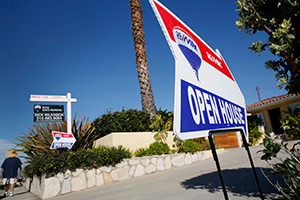Sales of Existing Homes Rise to Highest Level Since 2013

Sales of previously owned homes climbed in March to the highest level since September 2013 as job growth and cheap borrowing costs helped sustain the progress in residential real estate.
Closings, which usually take place a month or two after a contract is signed, increased 6.1% to a 5.19 million annualized rate last month, figures from the National Association of Realtors showed April 22.
The median forecast of economists surveyed by Bloomberg News projected sales would increase to a 5.03 million rate. Prices rose by the most since February 2014.
Employment gains, low mortgage rates and better weather have the potential of unleashing pent-up demand as the spring selling season gets under way.
Bigger wage gains and more housing inventory to make properties more attainable would help provide another leg up for residential real estate.
“Existing-home sales are certainly not back to cycle highs, but they’re pretty close to something you would consider to be normal,” Stephen Stanley, chief economist at Amherst Pierpont Securities in Stamford, Connecticut, said before the report. “Employment and income are doing much better, and you’re moving further and further away from the bust, so people who had been cautious for a while are starting to dip their toe in the water.”
Estimates in the Bloomberg survey of 80 economists ranged from a sales pace of 4.85 million to 5.2 million. February’s pace was revised to 4.89 million from a previously reported 4.88 million.
Compared with a year earlier, purchases increased 13.5% in March on an unadjusted basis.
The median price of an existing home surged 7.8% to $212,100 from $196,700 in March 2014.
The number of existing properties on the market rose 5.3% to 2 million in March from a month earlier. At the current pace, it would take 4.6 months to sell those houses compared with 4.7 months at the end of February. The inventory of unsold homes was up from 1.96 million a year earlier.
The median time a home was on the market decreased last month to 52 days from 62 days in February.
“Housing is recovering, but home prices are rising too fast,” Lawrence Yun, NAR chief economist, said in a news conference as the figures were released. “The only way to relieve housing cost pressure is to have more supply coming onto the market.”
Purchases of existing homes increased in all four regions, led by a 10.1% gain in the Midwest. Sales climbed 6.9% in the Northeast, 6.3% in the West and 3.8% in the South.
Sales of single-family homes increased 5.5% to an annual rate of 4.59 million, the report showed. The sales pace of multifamily properties including condominiums advanced 11.1% to 600,000.
Cash transactions accounted for about 24% of all purchases in March, according to the report. Sales of distressed property, including foreclosures, accounted for 10% of the total, down from 11% a month earlier.
The housing market has struggled to gain momentum in recent months as rising property values and strict lending standards for some limit purchases by those who are more sensitive to prices, such as young adults and low-income Americans. First-time buyers accounted for 30% of all purchases in March, NAR’s report showed.
Commerce Department data showed last week that housing starts rose less than forecast from the weakest pace in more than a year, while applications for new-home construction also fell amid a slump in permits for multifamily projects such as apartment buildings.
Homebuilders, however, are confident better times are ahead. The National Association of Home Builders/Wells Fargo sentiment gauge rose to the highest level since January amid improved buyer traffic and a better sales outlook. Improving weather also may help the housing industry as buyer traffic picks up in the spring.
“While the first-quarter economic headlines, again, demonstrated that the economic recovery has been uneven, I believe the underlying economic expansion, that is approaching its sixth anniversary, remains largely on track,” John Stumpf, CEO at Wells Fargo & Co., the nation’s largest home lender, said on an April 14 earnings call. “Interest rates remain low, homes are affordable, consumer and small business confidence remains high, and the labor market is approaching full employment.”
As the Federal Reserve considers raising interest rates for the first time since 2006, the prospect of higher borrowing costs may persuade those who are hesitant to take the plunge. The average rate for a 30-year fixed mortgage was 3.67% in the week ended April 16, according to Freddie Mac in McLean, Virginia. The rate was 3.59% in February, the lowest in almost two years.


